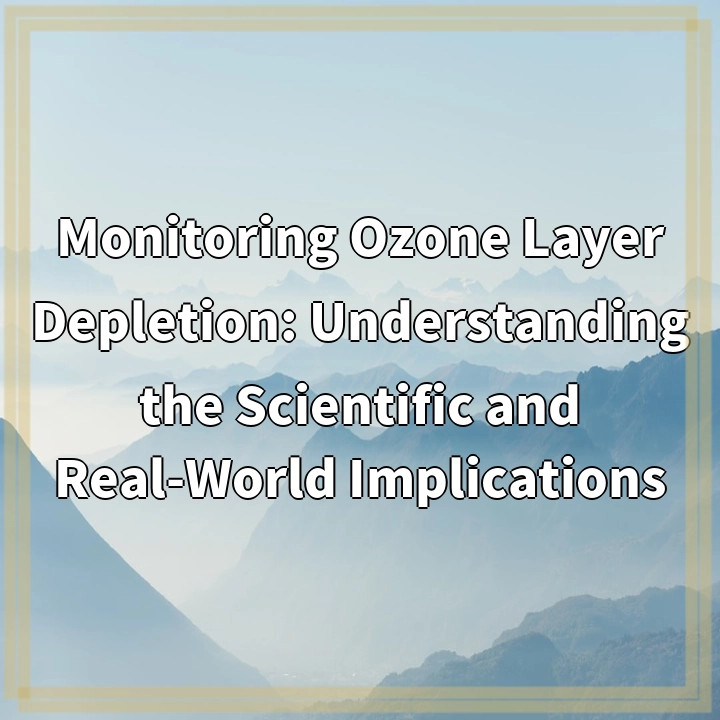
What is Ozone Layer Depletion?
Ozone layer depletion refers to the gradual thinning and weakening of the Earth’s ozone layer, particularly in the stratosphere. The ozone layer plays a critical role in protecting life on Earth by absorbing most of the sun’s harmful ultraviolet (UV) radiation.
Real-World Problems Associated with Ozone Layer Depletion
Ozone layer depletion can have several significant real-world implications, posing threats to both human health and the environment.
1. Increased prevalence of skin cancer
With the depletion of the ozone layer, more UV radiation reaches the Earth’s surface. This increased exposure to harmful UV radiation is directly linked to a higher risk of skin cancer, including basal cell carcinoma, squamous cell carcinoma, and melanoma. The decrease in ozone layer protection thus endangers the health and well-being of humans.
2. Harmful effects on human health
Exposure to excessive UV radiation can lead to other health issues beyond skin cancer. These can include weakened immune systems, cataracts and other eye problems, DNA damage, sunburns, and premature aging of the skin.
3. Negative impact on ecosystems and biodiversity
Ozone layer depletion also affects ecosystems and biodiversity. UV radiation can harm marine life, such as phytoplankton and coral reefs, which are vital components of the ocean ecosystem. Terrestrial ecosystems, including forests and agriculture, can suffer reduced productivity and biodiversity due to increased UV radiation levels.
4. Climate change implications
The impacts of ozone layer depletion extend to climate change. Certain chemicals, known as ozone-depleting substances (ODS), also contribute to climate change as greenhouse gases. As efforts to heal the ozone layer progress, the substitution of these ODS with alternative substances becomes crucial to mitigate their climate impacts.
In conclusion, monitoring ozone layer depletion is essential to understand the scientific intricacies behind this phenomenon and its real-world implications. From increased skin cancer rates and harmful health effects to risks for ecosystems and climate change, addressing ozone layer depletion remains a crucial environmental concern.

Solutions to Address Ozone Layer Depletion
Addressing and mitigating ozone layer depletion requires a combination of scientific research, international cooperation, and policy interventions. Here are some key solutions:
1. Phasing out ozone-depleting substances (ODS)
The most effective way to combat ozone layer depletion is to reduce and ultimately eliminate the production and use of ODS. The landmark Montreal Protocol, an international agreement signed by almost every country, aims to phase out the production and consumption of ODS. Continued adherence to this protocol is essential to ensure a healthier ozone layer.
2. Promoting alternative substances and technologies
Efforts to transition away from ODS involve the promotion of environmentally-friendly alternatives. This includes developing and adopting new substances and technologies that are ozone-safe and have lower or no environmental impact.
3. Enhancing public awareness and education
Creating public awareness about the harmful effects of ozone layer depletion is crucial. Educational campaigns can help individuals understand the importance of protecting the ozone layer and encourage environmentally responsible actions, such as minimizing the use of ODS-containing products or using protective measures against UV radiation.
4. Strengthening international cooperation
International collaboration is vital for effective solutions. Countries must continue to work together to share scientific research, exchange best practices, and enforce regulations that support ozone layer protection. This cooperation also extends to monitoring and reporting on progress, ensuring transparency, and addressing emerging challenges.
5. Research and innovation
Ongoing research and innovation play a critical role in addressing ozone layer depletion. Advancements in scientific understanding, monitoring technologies, and policy development can contribute to more effective strategies for preventing further ozone layer damage and promoting its recovery.
In conclusion, addressing ozone layer depletion requires a multifaceted approach that combines phasing out ODS, promoting alternative substances, raising public awareness, strengthening international cooperation, and investing in research and innovation. By implementing these solutions, we can protect the ozone layer and safeguard the health of our planet for future generations.















